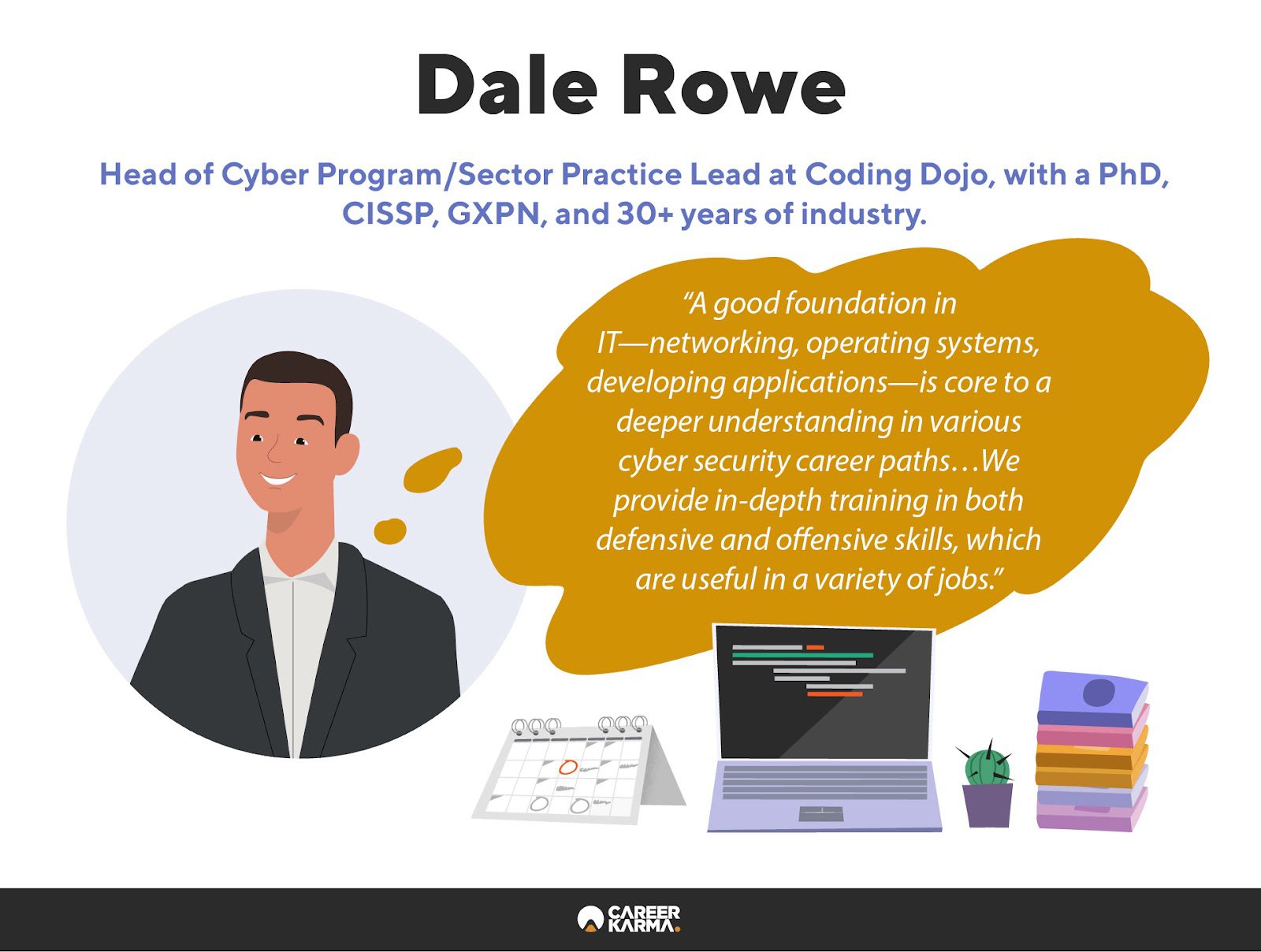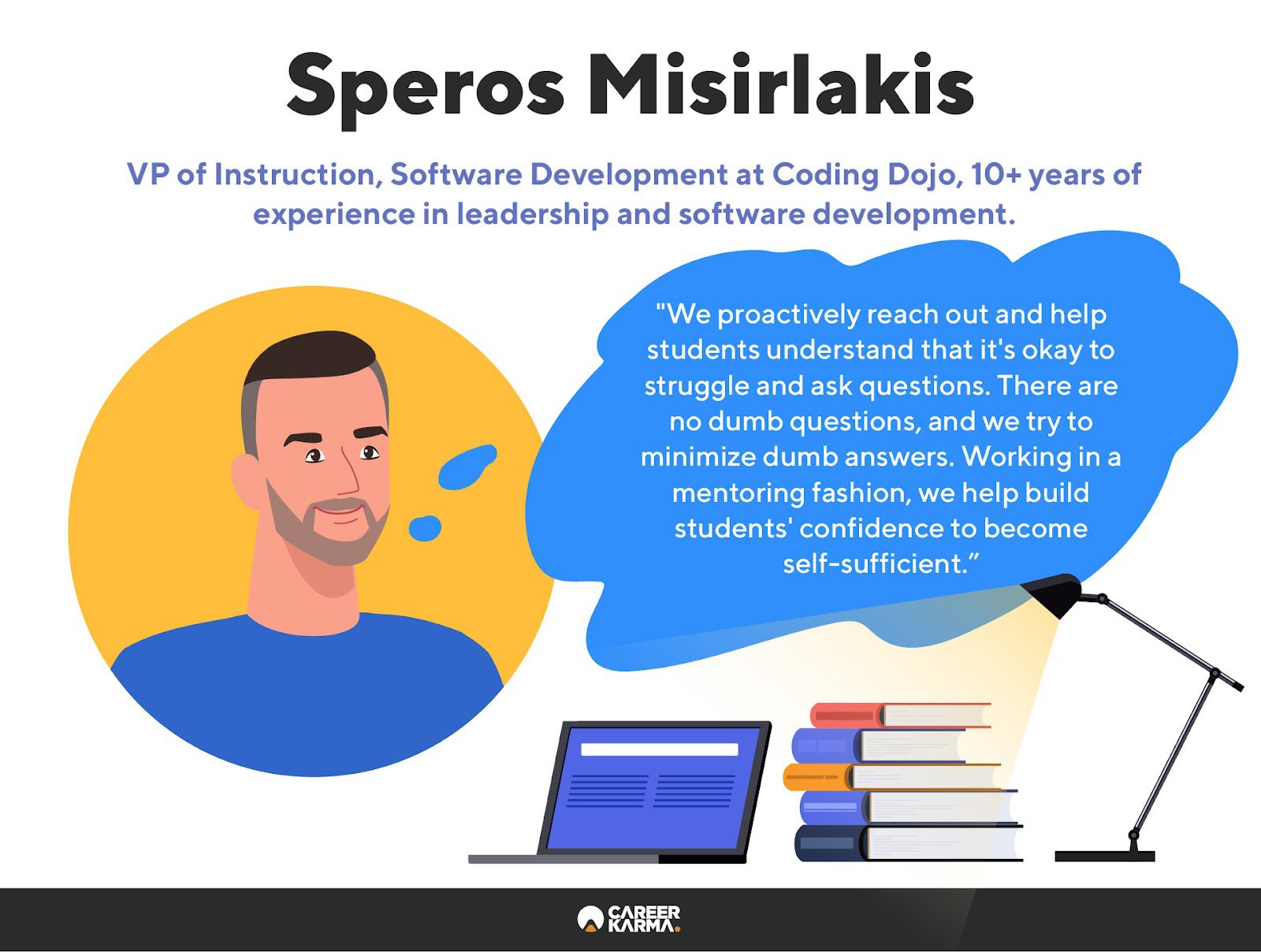The abundance of online resources, such as self-paced coding courses and UX/UI design tutorials, can make self-study appealing for those interested in starting tech careers. A quick search for keywords such as “coding classes,” “cybersecurity crash course,” or “UX design process” on YouTube results in hundreds of videos from a wide variety of sources. But although you can easily access material for self-study, mastering the content can take months—even years.
For this reason, bootcamps like Coding Dojo offer instructor-led courses for any aspiring tech professional. You’ll learn via market-led tech skills training and interact with instructors with real-world experience and much to share about what it’s like to work in the tech industry.
Sounds interesting? Read on as we look into the classroom experience at Coding Dojo and meet the instructors from whom you’ll be learning.
Coding Dojo offers immersive training programs, taught by a team of expert instructors committed to guiding students toward successful careers in tech.
Sign up for Coding Dojo today.What Makes Coding Dojo’s Teaching Approach Unique?
Coding Dojo’s unique teaching approach involves closely working with hiring managers to ensure that its curriculum covers the skills that tech companies need today.
Because its programs last three to six months, Coding Dojo does not seek to teach students everything there is to learn about their chosen tech field—an otherwise impossible feat considering how dynamic the industry is. Instead, instructors teach students how to grow into self-sufficient professionals and equip them with the necessary skills to succeed.
By the end of the program, students should develop problem-solving skills and the ability to learn how to learn. And, do they? Nearly 90 percent of Coding Dojo graduates landed jobs within 180 days of graduation, according to Coding Dojo’s 2020 Outcomes Report.
Meet Your Instructors at Coding Dojo
Behind Coding Dojo’s student success is the bootcamp’s team of expert instructors. Read on to learn more about their professional backgrounds and individual teaching styles.
Brenda Hungerford, Head of Data Science at Coding Dojo

Aside from being the Head of Data Science, Brenda is also an instructor and curriculum developer for Coding Dojo’s Data Science program. In addition, she holds an MS in Data Analytics and a PhD in Curriculum and Instruction.
What’s it like to learn data science at Coding Dojo? “We embrace a constructivist approach to learning, which means we build knowledge from the ground up and support our students through the process. We provide this support through examples and opportunities for students to apply their new knowledge every step of the way.”
An example of this approach is how Coding Dojo frames projects. First, learners complete two portfolio projects, each broken into simpler tasks that students must complete each week. Throughout the process, instructors offer feedback to make sure students polish their work before taking the next step.
“We have an extensive support system focused on individual student success,” says Brenda. These include one-on-one meetings with instructors, help from teaching assistants any day of the week, instructional support and peer learning through Discord, weekly code reviews, and individualized feedback on core assignments.
Douglas Bantz, UI/UX Design Instructor and Curriculum Developer

Douglas wears multiple hats at Coding Dojo. He teaches the UI/UX design program, develops the curriculum, and mentors students for their future careers while also being a design professional. This experience has given him great insight into the needs of the design industry.
Why should one learn UI/UX design? “[There’s a] huge amount of work coming down the pipeline. Most businesses are understaffed and need competent people to unclog these logjams. From recent experience, there’s a need for organizational flexibility or the ability to adapt and learn to roles that emerge from so much change in design groups.”
“Education plays a huge goal. Coding Dojo teaches not only the skills but the confidence to continue learning in your first position post-grad.”
What’s it like to learn UI/UX design at Coding Dojo? Coding Dojo’s UX/UI Design program starts with and builds off from the basics. “We start with simple research techniques that most people can grasp, eventually leading to more research and building products from what we really understand. Throughout, there’s extensive feedback and guidance.”
The exact process happens twice. Once to teach learners the theoretical aspect and a second time to put their skills and knowledge into practice. “When students can see the actual results of the techniques we teach, they own it and internalize it.”
“We run a ‘flipped classroom,’ meaning that students do the reading and content ingestion offline, then we work in collaborative design files to start the assignments that the student teams will finish later in the week. This gives us visibility to who’s doing what, the dynamics within teams, and who can potentially use extra guidance.”
He offered some helpful advice for those interested in the program. “Try hard, clear your calendar, and make sure that you understand that what you put into the work equals what you get out of it,” he said.
Dale Rowe, Head of Cyber Program

Dale Rowe, PhD, CISSP, GXPN has over 30 years of experience in IT, cybersecurity, and enterprise architecture, including principal architecture for military Satcom platforms. He is the Head of Cyber Program and Sector Practice Lead at Coding Dojo.
Why should one learn cybersecurity? Dale puts forward cybersecurity as an excellent place for career growth for those looking to break into tech. “There are over half a million open jobs in cybersecurity, and that’s not shrinking anytime soon. The best time to plant a tree was 20 years ago. The second best time is right now.”
Your first step? Take Coding Dojo’s Cybersecurity program.
What is it like to learn cybersecurity at Coding Dojo? “Our content is engaging and stimulating. We want students to understand the why and how, not just the what. Course materials are designed to help students ask, ‘So what?,’ ‘How does this help me?’, ‘Why?’, and then formulate these into questions and answers to deepen their understanding,” he shared.
Doing so encourages students to understand complex relationships and processes critically. This is in stark contrast to the traditional ‘sage on stage’ model, where the instructor serves as the sole source of knowledge and students as passive learners.
The program equips students with a good foundation in IT, from networking to operating systems to developing applications, which Dale says “is core to a deeper understanding in various cybersecurity career paths.”
He adds: “Students can go in many directions after this. We provide in-depth training in both defensive and offensive skills, which are useful in various jobs.”
Holistic learning is critical in the program, so students simultaneously undergo soft skills training. “Security professionals have to be able to speak to a wide variety of people with diverse technical backgrounds. So we help students develop and grow their capabilities from start to finish.”
Dale shares that over 50 percent of Coding Dojo’s Cybersecurity course is lab-based and highly collaborative. Challenges and tasks mimic real-world experiences to help better prepare students for the real world. All these combined ensure that students learn the most in-demand skills in cybersecurity and are ready for the job market.
Speros Misirlakis, Software Development Instructor

Software Development instructor Speros Misirlakis holds an MBA and has over 10 years of experience in leadership, development, and being a bootcamp instructor.
Why should one learn software development? Speros talked about the plentiful career opportunities available in tech. “There is an ongoing increase in job opportunities for software developers, specifically in the web development domain. It’s also never too late to start. Thankfully, once you learn the fundamentals of programming, you quickly reach a level of proficiency that matches you to many job opportunities,” he said.
What is it like to learn software development at Coding Dojo? Students work one-on-one with instructors throughout the day via chat and video conferencing to unpack topics like Python, Flask, CSS, and Java.
“We proactively reach out and help students understand that it’s okay to struggle and ask questions. There are no dumb questions, and we try to minimize dumb answers. Working in a mentoring fashion, we help build students’ confidence to become self-sufficient,” Speros shared.
Coding Dojo also provides students with opportunities to work in teams and pairs to hone their communication and collaboration skills, which are essential in the industry. The other vital skills include the following:
- A good grasp of the fundamentals of their domain
- An open mind
- Strong understanding of how to approach and solve problems methodically
- Good research skills
Coding Dojo’s software development program is fast-paced, and students must be ready to grasp large amounts of information and develop different skills in a short period. So for incoming Coding Dojo students, Speros had this to say: “Get ready to drink from the firehose.”
Learn from Tech Industry Veterans at Coding Dojo
Coding Dojo commits to setting its students up for career success. This is shown by Coding Dojo reviews, which are overwhelmingly positive. This commitment is why the school’s instructional staff comprises industry experts who provide both technical and practical training and all-around student support.
Ready to start your journey? Learn more about the Coding Dojo learning experience here.
About us: Career Karma is a platform designed to help job seekers find, research, and connect with job training programs to advance their careers. Learn about the CK publication.




